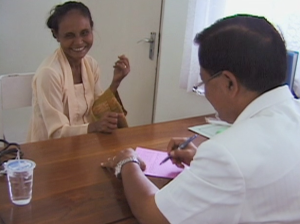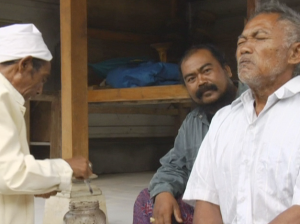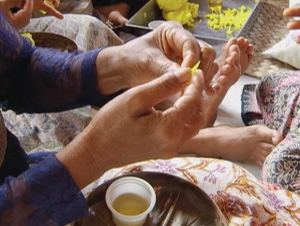CBDMH Psychosis Workshop Summary, Pt. 2
Rethinking Psychosis: Culture, Brain, and Context
Jan. 10–11, 2014
Workshop Summary
Part 2
Constance Cummings and Kathy Trang
Psychosis and the Environment
The last session ended with Laurence’s reflection on Steve’s “story” about the rabbit farm. Rob Lemelson (“Psychosis and Recovery in Cultural Context”) said the emphasis on “stories” was a fitting segue to his own longitudinal person-centered approach to studying severe mental illness in Indonesia – particularly aspects of subjectivity and recovery/outcome. Rob’s visual ethnographic research program began twenty years ago in response to the WHO’s call for ethnographic work to resolve a paradox: Persons living with schizophrenia in the developing world seemed to have better outcomes/recovery rates. Today’s talk, which was richly illustrated with film clips from his documentary series Afflictions, focused on three areas: diagnosis and healing, illness experience, and outcome (see also Lemelson & Tucker, in press-a; and Lemelson & Tucker, in press-b, for more on the making of Afflictions).
Diagnosis and healing
 The first series of clips focused on what was “at stake” for persons living with psychiatric disorder; Rob chose them to represent three different aspects of biomedical globalization in Indonesia. Gusti Ayu (The Bird Dancer) is a young woman from a small rural village in Central Bali with Tourette’s. In the first clip, Rob visits Gusti’s doctor and learns that she has “rejected all medications.” Rob visits Gusti at home surrounded by family and Gusti expresses disappointment that western medicine (as well as the traditional healers she has visited) “can’t cure me,” adding, “Is it really my destiny to be so unlucky?” She also says she is teased inside and outside the home, and wants an injection to help her commit suicide to free her parents. Rob described the second clip as a “standard medication consultation” between an Indonesia psychiatrist and her patient Nyoman Kereta (Shadows and Illuminations), an older Balinese man diagnosed with paranoid schizophrenia who takes thorazine. The third clip focused on Ni Ketut Kasih (Ritual Burdens), an older Balinese woman from a rural village diagnosed with bipolar disorder, who has suffered several relapses/hospitalizations. Ketut is responsible for fulfilling the family’s demanding ritual obligations. She visits a public health clinic for a medication consultation (and some psychotherapy), where she admits, “I cannot stop the stress, I relapse every time I resist it.” Interestingly, stigma only appears to be an issue for Gusti, who suffers from a neuropsychiatric disorder that might in the west be considered far less debilitating than schizophrenia or bipolar disorder. Both Kereta and Ketut appear to be surrounded by caring family members.
The first series of clips focused on what was “at stake” for persons living with psychiatric disorder; Rob chose them to represent three different aspects of biomedical globalization in Indonesia. Gusti Ayu (The Bird Dancer) is a young woman from a small rural village in Central Bali with Tourette’s. In the first clip, Rob visits Gusti’s doctor and learns that she has “rejected all medications.” Rob visits Gusti at home surrounded by family and Gusti expresses disappointment that western medicine (as well as the traditional healers she has visited) “can’t cure me,” adding, “Is it really my destiny to be so unlucky?” She also says she is teased inside and outside the home, and wants an injection to help her commit suicide to free her parents. Rob described the second clip as a “standard medication consultation” between an Indonesia psychiatrist and her patient Nyoman Kereta (Shadows and Illuminations), an older Balinese man diagnosed with paranoid schizophrenia who takes thorazine. The third clip focused on Ni Ketut Kasih (Ritual Burdens), an older Balinese woman from a rural village diagnosed with bipolar disorder, who has suffered several relapses/hospitalizations. Ketut is responsible for fulfilling the family’s demanding ritual obligations. She visits a public health clinic for a medication consultation (and some psychotherapy), where she admits, “I cannot stop the stress, I relapse every time I resist it.” Interestingly, stigma only appears to be an issue for Gusti, who suffers from a neuropsychiatric disorder that might in the west be considered far less debilitating than schizophrenia or bipolar disorder. Both Kereta and Ketut appear to be surrounded by caring family members.
Illness experience
 The second series of clips dealt with traditional medicine. During one segment, Rob visits a healer and asks him to “tell us the story of Pak Kereta.” The healer said he was mute and living in fear, possibly due to ngeb, an illness caused by other people (similar to witchcraft). Kereta lived with the healer for three months and was treated with different ancestral medicines “to ward off witchcraft.” Kereta also revisits the healer and is treated with medicinal drops in his eyes. But he and his wife seem to feel that going to the doctor and taking a pill is better. Carole Browner wondered why Rob had Kereta return to the traditional healer in the course of the film. The point was that, although Kereta appeared to suffer from psychosis, the belief that spirits enter his body and voices command him to do things was still within the realm of what was real/imaginable in Indonesia.
The second series of clips dealt with traditional medicine. During one segment, Rob visits a healer and asks him to “tell us the story of Pak Kereta.” The healer said he was mute and living in fear, possibly due to ngeb, an illness caused by other people (similar to witchcraft). Kereta lived with the healer for three months and was treated with different ancestral medicines “to ward off witchcraft.” Kereta also revisits the healer and is treated with medicinal drops in his eyes. But he and his wife seem to feel that going to the doctor and taking a pill is better. Carole Browner wondered why Rob had Kereta return to the traditional healer in the course of the film. The point was that, although Kereta appeared to suffer from psychosis, the belief that spirits enter his body and voices command him to do things was still within the realm of what was real/imaginable in Indonesia.
Following up on this, Ian Gold asked if persons living with mental illnesses in Indonesia had a biomedical concept of what was occurring; that is, did they differentiate between therapy in the form of a pill based on a western scientific model and another kind of medicine, or did they just think of each as a viable option. Rob didn’t think Kereta or Gusti or their families had a detailed understanding of the biomedical model. If a pill worked, they didn’t invoke models of the brain; Kereta simply told Rob the spirits became “fuzzier.” Rob tended to hear far more elaborate explanations of illnesses based on traditional Balinese medicine (e.g., ngeb).
For clarification, Laurence Kirmayer asked about the patients’ attitudes toward institutions offering treatment and whether patients had a certain degree of confidence in them, or whether it was (likewise) a very pragmatic trial-and-error approach. What was it about the level of institutional authority or endorsement that made people participate when they did not have a clear understanding of the model or mechanisms underlying their treatment? Rob replied that, regarding Kereta, the answer is difficult because he witnessed the 1965 genocide that killed his father and butchered his village. However, generally speaking, the experiences of people in Indonesia are very different depending on whether they live in a more globalized (e.g., Bambang Rujito in Memory of My Face) or traditional society (e.g., Ketut in Ritual Burdens).
Outcome
The next section of Rob’s presentation focused on Bambang Rujito, a highly educated man raised in Jakarta who had once worked for Reuters and was diagnosed with schizoaffective disorder. The first and part of the second clip were filmed in the psychiatric ward of a large state hospital in Central Java. In an interview with Rob, Bambang (who appears to be experiencing a manic episode) weaves fragments of Dutch colonial history, Indonesian politics, popular culture, and global events into his part of the dialogue. (Elsewhere Rob recalled, “the semantic content was almost entirely unintelligible to me.” It was only after analyzing the footage “that we were able to untangle the complex layers of allusion, meaning, emotion, and symbolism” Lemelson & Tucker, in press a, p. 22–23). Out of the hospital, Bambang explains that his hallucinations “were about what I read, what I heard, things I deeply felt” (e.g., he describes one hallucination in which a funeral procession is a “Soviet battalion”). Rob’s third clip is an interview with Ketut, the rural Balinese woman, to reinforce the comparison between Bambang (a more “globalized subject”) and Ketut (a more traditional or “localized subject”).
 As Laurence remarked, there is in each of us an interplay between the narrative self and a “more fundamental, embodied experience of the self” (the latter was particularly evident in the way Ketut described her illness as feeling her chest split open with a bamboo blade, or “as a hole in my head, and there was rice and sand debris in it”). Rob’s work implies this leads to different kinds of subjectivities. Georg Northoff asked for clarification on whether the globalized/localized distinction referred to the content of Bambang and Ketut’s symptoms vs. the symptoms themselves. Regarding the latter, as a neuroscientist, he is inclined to believe they relate to the function or dysfunction of “certain predisposed mechanisms in the brain” under certain constraints (content is provided by the specific environment shaping our experiences). Rob wasn’t sure if we should make a strictly binary – content-process – distinction, particularly in the case of Bambang. Georg agreed (ontologically speaking), but said that methodologically speaking in neuroscience some distinction has to be made. Rob agreed, but pointed out that neuroscience is currently relatively limited in terms of being able to “get at” the level of complexity at which culture and aspects of the self interact (i.e., subjectivity). For Laurence, Rob’s methodology complicates the exploration of Bambang’s subjectivity, his experience of being agonized by his illness and also being highly self conscious and feeling compelled to perform for his interlocutors (including Rob) and the camera. (At one point, Bambang sings directly to the camera, “Radio, someone still loves you,” and then asks the visiting psychiatrist, “How can I become a normal person so I don’t have to sing?”) Georg said he basically agreed that subjectivity is not located in brain, mind, or environment; it is more like a bridge, but one in which the bridge appears first, then the two sides that are connected by the bridge develop. He imagined this is also what Rob had in mind when he spoke about Bambang’s subjectivity being deeply interwoven with the globalizing world.
As Laurence remarked, there is in each of us an interplay between the narrative self and a “more fundamental, embodied experience of the self” (the latter was particularly evident in the way Ketut described her illness as feeling her chest split open with a bamboo blade, or “as a hole in my head, and there was rice and sand debris in it”). Rob’s work implies this leads to different kinds of subjectivities. Georg Northoff asked for clarification on whether the globalized/localized distinction referred to the content of Bambang and Ketut’s symptoms vs. the symptoms themselves. Regarding the latter, as a neuroscientist, he is inclined to believe they relate to the function or dysfunction of “certain predisposed mechanisms in the brain” under certain constraints (content is provided by the specific environment shaping our experiences). Rob wasn’t sure if we should make a strictly binary – content-process – distinction, particularly in the case of Bambang. Georg agreed (ontologically speaking), but said that methodologically speaking in neuroscience some distinction has to be made. Rob agreed, but pointed out that neuroscience is currently relatively limited in terms of being able to “get at” the level of complexity at which culture and aspects of the self interact (i.e., subjectivity). For Laurence, Rob’s methodology complicates the exploration of Bambang’s subjectivity, his experience of being agonized by his illness and also being highly self conscious and feeling compelled to perform for his interlocutors (including Rob) and the camera. (At one point, Bambang sings directly to the camera, “Radio, someone still loves you,” and then asks the visiting psychiatrist, “How can I become a normal person so I don’t have to sing?”) Georg said he basically agreed that subjectivity is not located in brain, mind, or environment; it is more like a bridge, but one in which the bridge appears first, then the two sides that are connected by the bridge develop. He imagined this is also what Rob had in mind when he spoke about Bambang’s subjectivity being deeply interwoven with the globalizing world.
This prompted a discussion between Laurence, Carole, Marjorie, Ian, and Georg about changes to both form and content of mental disorder over time correlating with changes in subjectivity. Should even form be understood, at least in part, historically? E.g., is the decrease in catatonic schizophrenia related in some way to an increase in schizoaffective disorder in response to more manic aspects of globalizing society? (But to some extent, Georg pointed out, it also depends on the diagnostic framework in use, e.g., hysteria vs. PTSD.) Marjorie Kagawa-Singer had a final question about the sociality aspect of mental illness in Indonesia; families did not appear to ostracize or exclude their ill relatives. Marjorie wondered about subjectivity and the degree of symptomatology the ill relatives expressed; are they modulated by the social network? Marjorie noted that Ketut did not seem to have the same degree of awareness about her condition or sense of shame as Bambang in a manic state For Marjorie, they seemed to have different senses of the torment they suffered. But Rob said Ketut was keenly aware of her suffering. Rob’s last clip suggested that love is a critical factor to differential outcome, an observation shared by Elyn Saks and Eric Kandel at the FPR’s 4th interdisciplinary conference on culture and mental illness.
Psychosis and the Self
Georg Northoff (“Understanding the Self: A Cultural Neuroscience Approach”) began his talk by trying to give the participants a sense of what a person living with schizophrenia is actually feeling, the extent to which they feel “locked in” and cannot “properly relate to themselves, to their own body, and to the environment.” For Georg, schizophrenia is a disorder of a basic (i.e., non-cognitive) sense of subjectivity, a conceptualization with deep roots in German-speaking psychiatry, but also manifested in current phenomenological accounts by Josef Parnas, Louis Sass, and others, who note a disrupted “pre-reflective, pre-conceptual attunement.” Here, the concept of attunement refers to our intrinsic – or prereflectively self-aware – relationship to the world, including one’s own body, “as a basic organizational feature,” such that all experience is experienced in the first person.
There are several forms of attunement. Regarding schizophrenia, phenomenologists make a distinction between the objective body and the “lived” body. According to Georg, persons with schizophrenia have trouble making the transformation from, or “subjectivizing,” the objective body. (Recall the “perceptual aberrations” noted in DSM-5’s description of attenuated psychosis syndrome.) He said this disruption impairs one’s inter-subjective and intra-subjective attunement (b/w various sensory and cognitive aspects and functions) as well as one’s relation to environmental stimuli, inducing a sense of detachment. Geog suggested that the symptoms of schizophrenia arise as “secondary, compensatory strategies” in response to problems with attunement.
The question is how to link phenomenological accounts to the brain; Georg provided two empirical examples for brain-based approaches to understanding phenomenological descriptions. Northoff and colleagues used an experimental paradigm in which subjects undergoing fMRI had to perceive/count their own heartbeat and perceive/count a synchronous auditory tone of the same frequency as the heartbeat (NB: perception and judgment periods were clearly distinguished since latter introduces some cognitive confounds). The results suggest that the subjective experiential or phenomenal component of body awareness may be related to the processing of the difference between interoceptive and exteroceptive stimuli in, e.g., the insula, which receives afferents from both modalities, rather than to the processing of interoceptive stimuli in isolation.
The group is currently conducting the same study in persons living with schizophrenia, who show differences with interoceptive and exteroceptive processing. Descriptively, he suggested that the interoceptive stimuli generated by the internal environment, which usually carries a higher degree of self-specificity, are no longer “embedded” or “put in the context” of the exteroceptive stimuli from the external environment. The lack of contextualization might lead to a loss in the ability to experience one’s body as self-specific.
The second example regarded subjectivity and the sensory (auditory) cortex. To experience stimuli, a necessary first step is to relate the stimuli to oneself (in other words, self-specificity is an extrinsic feature of the stimulus). Northoff and colleagues tested whether the subject’s own name, a highly self-specificity-inducing stimulus, recruits neuronal activity in the auditory cortex, vs. a familiar name or an unknown name. The stimuli were also presented in different voices. The researchers found a distinction between self and non-self in the auditory cortex (although, as participants noted, the self is deeply rooted in the brain, well below the level of the cortex, and these effects, or integrated neural mappings, could “percolate up to the cortex”; Georg agreed, the point is that every external stimulus is encoded in relation to the self). The distinction suggests a pre-disposition (or “priming”) in resting state activity in auditory cortex for one’s own name as highly salient.
Interestingly, for patients prone to auditory hallucinations there is very little difference between task-evoked and resting state activity and its spontaneous fluctuations in the auditory cortex (NB: change in degree of activity is significant for encoding). This work suggests that schizophrenia as a disorder of the self is a basic deficit that generates the kind of aberrant neuronal activity imaging captures at the macro level.
At this point in the talk, Georg posed a series of questions: Does the level of resting state activity impact the degree of activity induced by external stimuli? How does resting state interact with the stimulus? There is strong overlap between areas of the brain that show high resting state/spontaneous activity and responses to self-specific stimuli/tasks. Using a simple experimental task (eyes open [EO] vs. eyes closed [EC] followed by EO/EC with exposure to names) Northoff and colleagues (Quin et al., 2013), found no difference between EO/EC relative to respective baselines when presented with own name vs. a familiar name or an unknown name. Here, both resting state conditions appear to have special information encoded in them that allow subjects to react differently to own name. In other words, Georg suggested that the resting state might not only be pre-reflective attunement of resting state activity but pre-phenomenal (i.e., prior to experience), such that subjectivity is already deeply encoded in (unknown) features of the resting state, and the encoding in these features may be lost in schizophrenia. (The inability to subjectivize auditory inputs may cause persons with schizophrenia to attempt to generate meaning, which has been lost, via some higher order cognitive function.)
Finally, he discussed research investigating the relationship between self and consciousness (frequently conjoined) in patients in a vegetative state. The question was how the patients would respond to own name and to some autobiographical detail. Almost all subjects showed some activity in auditory cortex, particularly in response to own name. Separate studies suggest that the degree of difference between self and non-self neuronally predicts the degree of consciousness, and in turn the self/non-self distinction was predicted by the intrinsic activity of the resting state. The distinction is not only deeply embedded but diffuse: resting state activity occurs throughout the brain.
The following points were raised in the discussion that followed Georg’s presentation.
- Vanessa Singh brought up Mary Helen’s early comment regarding integrated inputs related to consciousness percolating up from the brain’s subcortical regions. Georg agreed, adding you can have limited consciousness without a cortex, but that’s not the seat of consciousness. Mary Helen pointed out that you can also have a sense of self with extensive damage to the cortex. Georg said you have to distinguish between “a sense of self” and a “self.” (Vegetative patients have a self, but not necessarily a sense of self.) He also said that integrative regions like the pACC (perigenual area of the anterior cingulate cortex) make a contribution to a sense of self but self-related processing as part of the brain’s intrinsic activity is necessary to it. (Laurence wondered about the developmental aspect of this.)
- Beate Ritz related the discussion to the innate immune system vs. the acquired immune system and the problem of auto-immunity, which suggests the loss of distinction between self/non-self. These disorders are often related to viruses or infections (prenatal infection is a risk factor for schizophrenia). Beate wondered if we could use the immune system as a metaphor for what the self really is. Georg mentioned the work of philosopher-immunologist Alfred Tauber, who argues that the immunological self is flexible, depending upon the context; it’s not a fixed entity. Georg thought neuroscience could learn a lot from that characterization.
- Ian Gold brought up Cotard’s syndrome, the belief that you are dead, in relation to Georg’s discussion of intero- and exteroceptive contrastive processing in the insula. Is Cotard’s a disorder of interoception? (“It’s always puzzled me that someone could have a nihilistic belief about their own body, but not about anything else.”)
- Brian Anderson wondered about the general flow of discussion, which focused on underlying processes rather than symptoms. Would NIMH’s RDoC initiative be interested in funding this kind of work? Georg felt in ten years it will be much easier to get funding, “because the data will show it.” He emphasized designing good studies and asking your patients whether your ideas make sense.
- Laurence asked Georg to say something about language (the “narrative self”). Georg said his work operates on a level prior to language and even prior to experience. Many of his patients “have no words for the kinds of experiences they are having”; hence the simplicity of his paradigms. Laurence agreed on one level, but also thought language/the process of narration is not epiphenomenal, “it re-enters into this and re-shapes it.” Georg more radically suggested that any neural activity generates meaning, and that meaning is not attached to language but comes from the relation to the environment and to context.
Further Reading
Lemelson, R., & Tucker, A. (in press-a). Steps toward an integration of psychological and visual anthropology: Issues raised in the production of the film series Afflictions: Culture and mental illness in Indonesia. Ethos.
Lemelson, R., & Tucker, A. (in press-b). Afflictions: Psychopathology and recovery in cultural context. In L. J. Kirmayer, R. B. Lemelson, & C. A. Cummings (Eds.), Revisioning psychiatry: Cultural phenomenology, critical neuroscience, and global mental health. New York: Cambridge University Press
Northoff, G. (2013a). Unlocking the brain: Coding. Vol. 1. New York, NY: Oxford University Press.
Northoff, G. (2013b). Unlocking the brain: Consciousness. Vol. 2. New York, NY: Oxford University Press.


